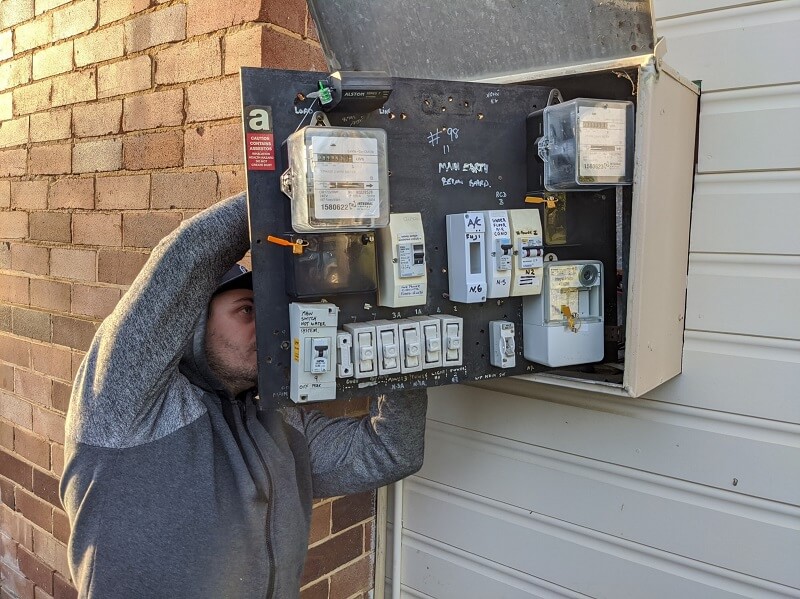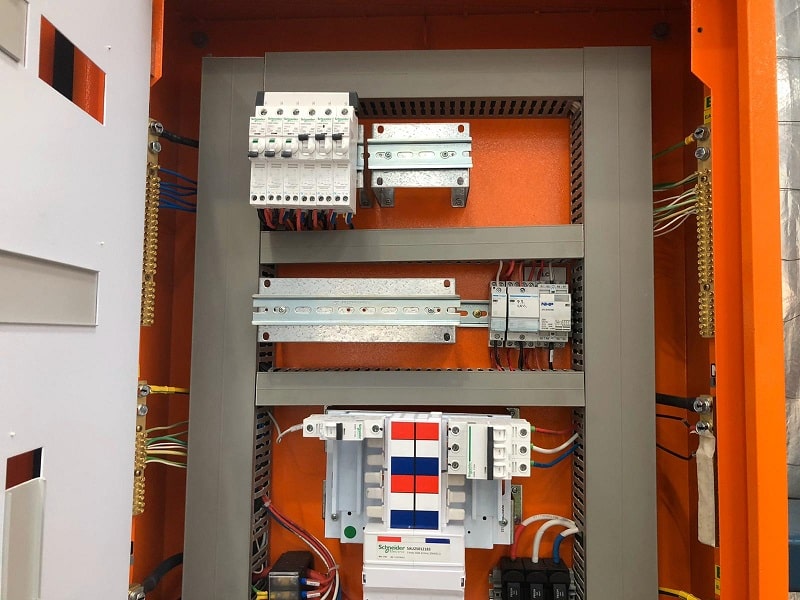A switchboard is the focal point of any building where the entire electrical distribution of all wires come together. Strictly speaking, it’s the brains behind all your electrics that takes the mains electricity from outside and distributes it to every electrical power outlet in your home or business.
They contain safety switches, fuses, or circuit breakers which are usually located at the front of the property. Once you start making upgrades to your home or business, you will need a switchboard upgrade to cater for the change in power so that the existing circuits don’t overload and cause a hazard.
Table of Contents
What Is a Switchboard Upgrade?
A switchboard upgrade is an upgraded version of any current switchboard. If a home or business owner wants to make changes or alterations to their electrical system, electrical contractors are required to bring the whole installation up to current codes and standards.
These upgrades happen to enable modern electrical switchgear such as an RCD (residual current device) safety switch in the upgraded switchboard, to provide homeowners with maximum safety for their families. This is your electrocution protection for your electrical system.
For example, in case of potentially dangerous hazards like an electrical fire or electrical shock that occur when the current switchboard still uses ceramic fuses and from power overloads due to higher-powered appliances.
Why Do You Need to Upgrade Your Switchboard?
Since technology has taken the world by storm in the past 20 years, the power consumption for these appliances has also increased. This has led to overconsumption and a demand for more power outlets in homes due to acquiring more technological equipment.
The old ceramic and porcelain fuses in switchboards are not equipped to cater for these technological upgrades and therefore require an upgrade to a modern switchboard that will cater for the growing electricity demands.
Under the new laws of Australia’s Energy Standards, a switchboard upgrade is required if you:
- Upgrade to higher-powered electrical goods
- Receive an electrical defect notice
- When you make additions or alterations to your electrical system. Such as new lighting or powerpoints
- Adding a solar system
- Future-proofing your house
Common reasons for upgrading your switchboard
There are several reasons why a switchboard upgrade is necessary, such as:
- Your switchboard is old and uses ceramic fuses.
- Your fuse or circuit breakers trip when using many appliances at the same time.
- Flickering lights happen randomly around the house.
- Your electrical equipment shorts frequently.
- You hear a buzzing noise coming from the central hub switchboard.
- The fuses blow more frequently than before.
- The cables within the switchboard become overheated due to power overloads.
- You want to install more power outlets around your home.
- You have a need or desire for larger electrical goods that have a higher power consumption.
As the world develops bigger and better electrical goods, switchboards need to adapt to these changes in order to cater for more powerful appliances and prevent electrocution or electrical fires from happening.

Why Are Ceramic Fuses Not Safe?
Ceramic fuses were installed in Australian homes in the late 19th century as a safety device. As times have changed, these fuses have become obsolete in the technological world due to greater power consumption demands.
Fuses were the only form of protection at the time. They have needed to be replaced, as they only tripped the power when a short circuit or overload happened. Still, nowadays, with current electricity demands, these fuses are not built to handle them – and thus trip at any minor electrical usage.
For these reasons and the fact that the old switchboards don’t have circuit breakers, the ceramic fuse is deemed unsafe for 20th-century requirements.
What Is An RCD?
A residual current device (RCD) is a switch (a life-saving switch) that’s installed in switchboards. They act as a safety device to prevent any damage happening to people in the house and the switchboard due to an imbalance of power.
A Residual Current Device is a sensitive safety device that switches off the electricity within 10 to 30 milliseconds if there is an electrical fault. An RCD is is designed to protect against the risks of electrocution and fire caused by earth faults.
Your home may have circuit breakers installed, but these only protect against overloading and short circuits – not electrocution.
All RCDs have a test button that should be pressed every three months to simulate a fault and indicates whether the RCD is operating correctly.
On what circuits do I need RCDs?
RCD safety switches are required on all domestic final subcircuits as per the most recent change to AS3000.
They have been mandatory on all power circuits in new or extended homes since the early 2000s. It has been mandatory for about ten years on all lighting final subcircuits. The most recent change came a few years ago to include appliances such as hot water, air conditioning, ovens and cooktops.
Testing Safety Switches
You should test your safety switches twice a year by pressing the T or Test button. It should trip to the Off position; you then have to return it to the On position.
If your switch doesn’t trip, then you should turn off the power and call your electrician.
What’s Involved In a Switchboard Upgrade Process?
A switchboard upgrade process replaces the ceramic fuses for RCDs and circuit breakers along with other components.
We need to remove all the existing circuit protection. Identify all the cabling and label accordingly. Mount a new enclosure for our safety switches. Re-connect the cabling into the new RCDS. Terminate and label the enclosure.
Switchboard Upgrade Extras Include
Asbestos Panel Replacement
If your home was built more than 25 years ago, the switchboard in your home likely has an asbestos panel. This is a highly hazardous material and needs to be removed by a professional electrician (level 2) and upgraded to a modern switchboard.
Upgrading Your Consumer Mains
Older homes were fitted with electrical switchboards that were supplied with a maximum of 40A using a 6mm cable from the consumer mains. If you’re thinking of installing a pool, air conditioning units, or other large appliances, you will probably need to upgrade your consumer mains. The consumer mains is what connects the service lines from the street to your home.
Upgrades and Protection for Cables
It may be necessary to upgrade the cables in the switchboard if they have been previously tampered with by a DIY electrician and because the rewiring of the cables may cause damage or a potential fire due to overheating.
Repairs and Fault Finding
Sometimes when we upgrade the circuit protection, we find faults that the existing fuses or breakers weren’t picking up. This can sometimes lead to repairs and fault finding needing to be completed.
3-Phase Switchboard Upgrades: What Are They?
A 3-phase switchboard upgrade has three active wires and one neutral. These upgrades are designed to provide more power to successfully run high-power appliances in larger properties and buildings.
Some appliances can only operate on 3-phase power, such as large air conditioners, hot water systems, spas or even large ovens. A 3-phase upgrade may also be required to enable you to install more solar power onto your roof
What Are the Costs of a Switchboard Upgrade?
All switchboards present unique challenges. Pricing for one switchboard cannot be the same for the next. All switchboards must be quoted individually by one of our licenced electricians

FAQs
How long does a switchboard upgrade installation take?
Generally speaking, it should take approximately 4-8 hours when upgrading your residential switchboard, depending on the type of installation and your existing infrastructure. Larger commercial switchboards can take from 8-48 hours depending on their complexity.
Is a switchboard upgrade a legal requirement?
It is only a legal requirement to upgrade your switchboard under Australian standards when You make modifications or additions to your existing wiring system these can include the following:
- You have received an electrical defect notice
- You need to install major electrical appliances
- You need to install a new power outlet.
Key Takeaways
- A switchboard upgrade modernizes your electrical system to handle increased power demands and improve safety with devices like residual current devices (RCDs).
- Necessary for homes/businesses upgrading to high-powered appliances, adding solar systems, or requiring more outlets.
- Upgrades include replacing old fuses with RCDs and possibly upgrading consumer mains and cables for enhanced safety and capacity.
- Benefits include preventing electrical fires and shocks, and complying with Australia's Energy Standards.
- Costs and time for upgrades vary based on complexity and existing infrastructure.
What is an electrical defect notice?
A defect notice is a notice issued to homeowners stating that their electrical installations don’t comply with Australia’s safety standards and must be corrected as soon as possible by a qualified electrician.

Because of the ever-changing nature of technology, the context of electrical setups in houses is very different from when the Standards were first created. This may mean that your switchboard is outdate and due for an upgrade. If you would like us to make an assessment please get in touch today.
For more information on how switchboard upgrades, contact Fix Electrical Contractors today!

Adrian Faull
Adrian Faull is the founder of Fix Electrical Contractors. He is proud to lead a team of qualified electricians and support team that are experts in the field, who will work with you to ensure you’re getting the best electrical solution for your needs.
